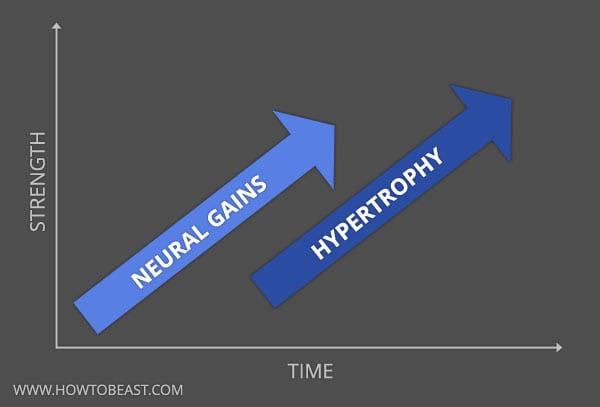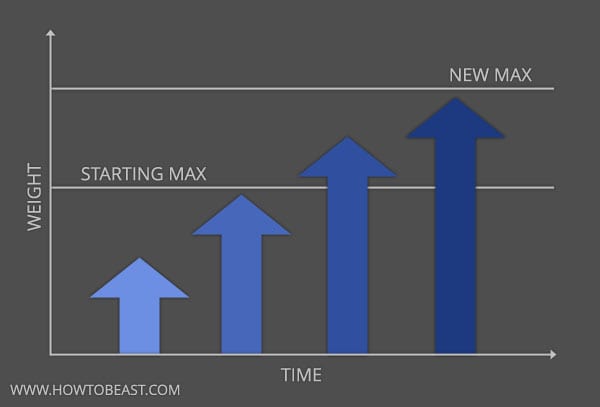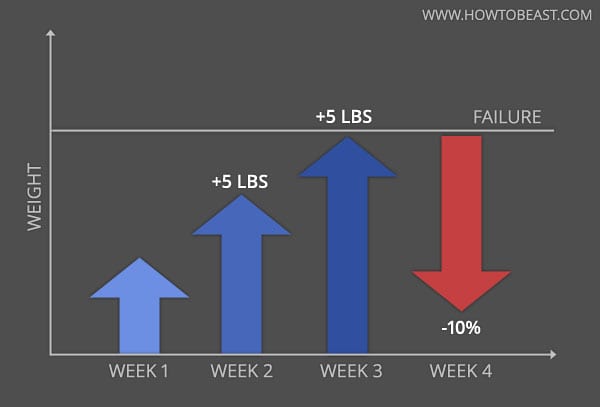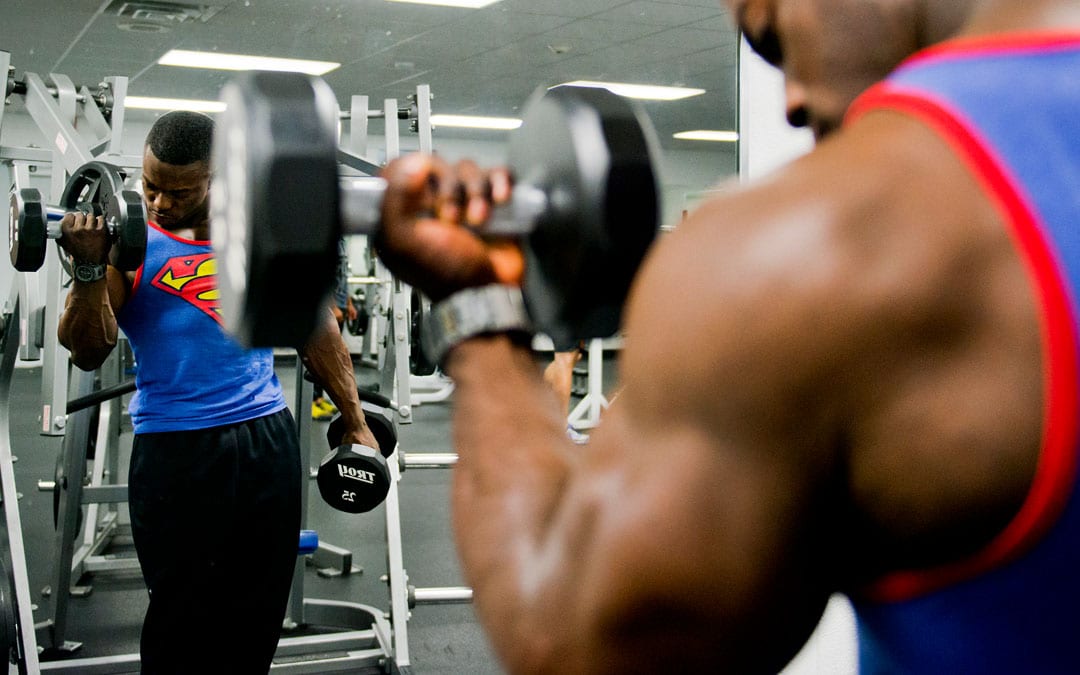There’s more to building muscle than just lifting weights and eating protein…
If you want to pack on mass at an optimal rate, then your training needs to be on point.
But what exactly makes a workout routine ‘good’ for building muscle?
There are many factors to this equation, but the most important one is progressive overload. In this article, I’ll go over what progressive overload is, and how to apply it to your workouts starting today…
But first I quickly want to review the basic correlation between strength and muscle growth, so you can understand why progressive overload is so important.
Why Strength is King (if Your Goal is Mass)

There are 2 main ways we can build strength: neural gains or muscular hypertrophy.
Neural Adaptations
The first way to build strength is to get better at performing a given exercise.
Take squats for example. During your first few months of squatting, increases in strength will come primarily from your body ‘learning’ how to squat.
The exact means by which this happens are twofold:
- First is simply learning proper squat form and fixing any mistakes you’re making
- Second is your nervous system adapting to the movement, and being able to activate more motor units and recruit more muscle fibers [1]
As you perform repetition after repetition, your brain and nervous system become more and more efficient at executing this specific movement. This allows you to build strength, and lift progressively heavier weights.
Hypertrophy (Muscle Growth)
Assuming you learn how to perform an exercise with proper form, these neural gains will be close to ‘maxed out’ after a few months of consistent training.
Don’t get me wrong, your nervous system will continue to adapt to the exercise, but the rate of improvement will extremely slow at this point.
In order to continue building strength, your body will begin to synthesize new muscle tissue. [2]
Just like with neural gains, this process will be fast at first (aka “noob gains”), but slow down over time. In order to maximize the amount of muscle you build, you need a properly programmed workout routine. In other words, you need progressive overload.
What is Progressive Overload?

Now that you understand why getting stronger is such an integral part of building muscle, let’s talk about progressive overload.
At it’s core, progressive overload is a very simple concept: by slowly increasing the weights you lift, your body must synthesize new muscle tissue to keep up with the ever-increasing demands.
Note: You can also increase the volume (sets X reps) of your workouts in order to achieve progressive overload. However, I recommend focusing only on the weights at first (while keeping the volume constant) to keep things simple.
One key thing to note is that you must start BELOW your current max. If you start by lifting the heaviest weights possible, you won’t be able to consistently increase the weights that you’re lifting.
Far too many guys make this mistake, and end up compensating by using poor form to lift more weight. This can lead to burnout and injury, and actually cause you to plateau… so avoid this at all costs.
However, assuming you start by lifting weights that are relatively light for you, and then increase the weight slowly, your body should be able to keep up and build mass as you go (eventually surpassing your previous max strength levels).
How to Start Using Progressive Overload Today

Now let’s get into the good stuff: how can you apply this to your training routine and kickstart your muscle growth TODAY?
There are many different ways to go about this, but I’m going to offer you what I consider to be the simplest and most elegant solution.
Just follow these steps:
- Choose a number of sets and reps for every exercise you do. Keep this simple and go with 3×8 if you’re unsure (or read my article on rep ranges).
- For each exercise, choose a starting weight that’s relatively easy for you. You should be able to do all of your sets and reps with good form.
- Increase the weight by 5 pounds every week. Keep the number of sets and reps constant.
- When you fail, subtract 10% of the total weight. Next week, use 90% of the weight you failed with and start again from there.
*Note: FAILURE means “technical failure”. When your form breaks down EVEN A LITTLE BIT, that means you failed.
It’s so important to drop the weight when you fail, because otherwise you won’t be able to continue increasing the weight. And this will lead to a plateau (in regards to your strength AND your muscle mass). Dropping the weight allows your body to “reset” and recover. You will likely break through that plateau once you increase the weights back to that point.
Also, your diet needs to be in check or you will fail to build new muscle and quickly plateau. Aim to eat enough calories to gain a little bit of weight (about 2 pounds per month). This will give your body the extra energy it needs to build muscle mass, but not so much that you gain a bunch of fat in the process.
The rest should be self explanatory. If you follow these steps, you will successfully apply progressive overload to your training, and your gains will go through the roof as a result!




David,
Your posts are always on point because I’ve dealt with them (as most guys have) before.
I’m not sure why I never deloaded but I guess it came to pride. When I started I’d progress for a few weeks and feel great. Then I’d stall, keep trying to lift the same weight, and fail. Then I’d get disgruntled and abandon all the progress I’ve made. So many people do this, and once you figure it out you feel like a complete idiot.
I 100% say that the best training program is the one you’ll stick with, even when you fail.
This is so true man: “the best training program is the one you’ll stick with.”
And yeah, I’ve made the same mistake letting my ego get in the way.
Thanks. The point about technical failure was a great reminder. Got to get that full range of motion to see results.
Thanks Alex. Respecting technical failure will make a big difference long term.
David great article.Could you please answer a question that i have about the progress scheme exemplify on the article. My workout routine is a full body 3x week, and i Bench, squats 3x week .According to your article, you should increase the weight on the bar every week, so for example, bench 225 x3 sets of 6 reps for all the 3 session of the week , and then on the following week i should bench 230 x3 sets of 6reps and if i won’t be able to do it, i should decrease the weight by 10% ? Thank you
Hey Andre,
Yes exactly, increase the weight on a weekly basis (not session by session).
Hey David,
Great article here! My best gains have come from when I am conscious with hypertrophy and actually track the results.. I used to go to the gym with a pen and pad, and jot down everything after I did it. This article makes it all more actionable
Hypertrophy helped with my progress and I think I need to start it up again. I’m working on gaining some weight as well – do you agree with ~50% carbs, 25% protein, 20% fat being optimal weight gain percentages?
Thanks and keep killing it out here!
– Evan
Hey Evan, tracking progress is definitely VERY important for making gains.
In terms of your percentages, I wouldn’t worry about it too much. Make sure you’re eating enough calories to gain weight and about 0.8 grams of protein per pound of bodyweight and you should be good to go!
Great article!
Thanks Zenon!
Back at college, I’d lift with my friends consistently and watch them use the same amount of weight training session after training session. It’s important to push yourself to gradually lift heavier. Progressive overload is key to maxing out the amount of muscle you can pack on and increasing strength. Great article David! Again, killing it with the infographics.
Thanks Nick, and good point. Most dudes just hit the gym, lift the same weights, and feel good about themselves. Got to push the limits to grow.
Great read David. I only train at home with my barbell and dumbbells with a bench. I tend to use a pyramid schedule, sometimes mixed in with supersets and/or drop sets, depending on the exercise.
I might try your ideas.
What do you think of my latest workout? I aimed to rest 60s between sets.
Deadlifts – 42kg x 15reps, 55.5×12, 64×8, 68.5 x 6, 68.5 x 4
BB Rows – 32 x 10, 42×10, 51×6, 46.5 x 8 (I dropped last set to 46.5kg as my left forearm is a bit injured)
Chinups 10, 10, 8 (+7kg added), 6 (+7kg added)
Military press 32×10, 36.5 x 4 failed then immediately dropped to 32×4, 32×8, 32 x 8
Cheers mate.
David,
Great article! Would you say this works the same for men over 50?
Great article! Hey David. Being awake is my greatest accomplishment. Whenever I go to the gym, I always see the same people there, and they always use the same weight. This piece makes it easier to put into practice.
This is great.
What is your last name, David? I need to reference you in my Science essay
This resource is very excellent! The sensation it creates against my eyeballs is quite pleasant. Please let me know if there’s a way to get notified when a new post is published.